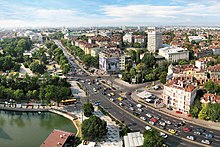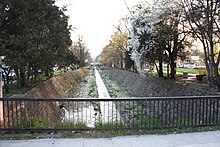Eagle Bridge (Sofia)

The Eagle Bridge ( Bulgarian Орлов мост / Orlow most) is a bridge in the center of the Bulgarian capital Sofia . It was built from 1889 to 1891. The name for the bridge was given by the four bronze eagles (Bulgarian орел / orel for German: eagle ) at the four corners of the bridge. At the time of its construction in 1891, the Eagle Bridge stood on the outskirts, today it is in the center of Sofia. Sofia's largest park, Borisowa gradina, begins at the Eagle Bridge .
The bridge crosses the small river Perlowska reka . At the time the bridge was completed in 1891, the river marked the eastern boundary of Sofia. Before that, there was an old wooden bridge at this point. The little river, barely two meters wide, is now channeled in an artificial concrete bed - very similar to the Wien River in Vienna.
Today the bridge is one of the most famous bridges in Bulgaria. The Eagle Bridge is next to the Lion Bridge the most famous and oldest surviving bridge in Sofia. The bridge forms the center of one of the busiest intersections and transportation hubs in Sofia. The square on which the Eagle Bridge is located is officially known as the Eagle Bridge Square (Bulgarian площад орлов мост / ploschtad Orlow most).
The bridge is located directly on the north corner of Borisova Gradina Park , near Lake Ariana , the Vasil Levski National Stadium , the Soviet Army Memorial and the main building of Sofia University .
description
The Eagle Bridge is a wide, massive stone bridge with an arch. Their wingspan is 15.8 m.
On both sides of the bridge there is a richly decorated, 10 m long cast iron railing, which also bears the date of completion in 1891.
The ends of the railings are flanked by stone pillars approx. 7 m high. These four square stone pillars ( obelisks with two mounted street lamps each) made of hewn granite, with classic geometrical ornamentation and ornaments, end in a cornice that is crowned with a stone ball. A bronze eagle with outstretched wings is enthroned on each stone ball. The four identical eagles (two are mirror-symmetrical to the other two) each look away from the bridge in the direction of travel of the bridge deck. Your head and your gaze is tilted slightly downwards and towards the bridge side. Therefore, despite their outstretched wings, they do not look like eagles just about to soar into the air, but as if they have just landed and are suspiciously watching and guarding the road leading over the bridge with an attentive glance turned sideways to the road.
In the lower part of the granite columns there is a plaquette with the Bulgarian coat of arms - a lion walking to the left.
The bridge was widened several times - at least three times - as can be seen in numerous photos. When it was built, the sidewalk, together with the roadway, was originally between the two cast-iron bridge railings, decorated with a lattice ornament, about 10 m long. Later the sidewalk was moved outside the historic bridge railing and only the roadway ran between the historic bridge railing. Another similar bridge railing was attached for the lateral bridge boundary of the sidewalks to the edge of the bridge. Later again, the northern side of the bridge was added and an additional lane was created for the tram line, which, coming from Tsar Iwan Assen II., Ran across the bridge towards the university. Very early on there was a tram line (No. 15 and 16) that ran from the city center to just before the Adlerbrücke. In 1970 the boulevard Zarigradsko schose was widened and in this context the bridge was widened by moving the northern bridge railing. In addition, the pedestrian tunnel was built under the Zarigradsko schose (on the southeast side of the bridge). The Eagle Bridge was redesigned again in 1991. Among other things, the tram tracks were removed during this or a little later, as well as in the street Tsar Assen Iwan II and on the boulevard Tsars Oswoboditel to the university.
The two historical bridge railings are currently approx. 30 m apart. Between them run four lanes inward and three lanes out of town. Another carriageway runs at the northern end of the bridge, where the tram tracks that come from Tsar Oswovboditel street used to be laid. The side railing of the sidewalk, facing the river, is now in a very simple and cheap design on both sides.
At the Eagle Bridge, the Boulevard Evlogi and Christo Georgiewi (бул. Евлоги и Христо Георгиеви), which runs on both sides of the Perlowska reka, and the Boulevard Zarigradsko schose (coming from the east), which then leads west to the city center, cross and the name Boulevard Tsar Oswoboditel carries. Because of the boulevard Ewlogi and Christo Georgiewi running on both sides of the Perlowska reka, the intersection is designed as a double intersection, with the actual eagle bridge between the two intersections.
The small side street Zar Iwan Assen II also joins the bridge crossing . If you are coming from the south-east on the boulevard Zarigradsko schose into the center of Sofia, then the Adler Bridge is the first street crossing over which you drive into the actual city center.
The traffic jams all day long on the bridge crossing, as the populous residential areas of the satellite towns (including Mladost 1 to 4) are in the east of Sofia and can be reached mainly via the Eagle Bridge and the Zarigradsko schose boulevard behind it . That is why 14 bus routes run across the Adlerbrücke. A very busy interchange stop is located directly behind the bridge on the Zarigradsko schose . Even the Sofia Airport , which is located east of the city center, can be reached via the Eagle Bridge. Long-distance traffic also leads over this bridge to the eastern cities of the country - Plovdiv is 150 km to the east. The route leads over the Eagle Bridge and the Zarigradsko Schose to the A1 Trakija motorway , which connects Sofia with the Black Sea city of Burgas .
The river turns 30 ° to the right 30 m behind the northeast side of the bridge.
history
Sofia was declared the capital of the Principality of Bulgaria in 1879 . In the following years, the construction of numerous representative structures, including the Eagle Bridge, began in order to catch up with Europe's metropolises in terms of the cityscape. In 1888, the Sofia City Council decided to build the bridge as a symbolic eastern entrance to the new Bulgarian capital. Until then, there had only been an old wooden bridge at this point, marking the eastern border of Sofia. This is where the road to Constantinople (now Istanbul) began, known in Bulgaria as Tsarigrad - the city of the Tsars - the Eastern Roman emperors and Ottoman sultans.
In the absence of adequately trained Bulgarian specialists, the city council, as with many other building projects in Sofia at the end of the 19th century, required suitable foreigners to carry out this task. In this case, the Czechs Antonín Kolář (chief architect of Sofia; † 1905) and Václav Prošek , an engineer and co-owner of the nearby Prošek brewery , were entrusted with the design of the bridge. The bridge was then built by architect Václav Prošek, as well as his brother Josef Prošek and his cousins Bogdan Prošek and Jiří Prošek , who was an engineer. Václav Prošek designed and built the similar Lion Bridge (built from 1888 to 1891) as early as 1889 . The construction of the Adlerbrücke (built 1889 to 1891) was finished in 1891, in the same year as the completion of the almost identical Lion Bridge.
The design and elaboration of all metal elements for the eagle bridge - the four bronze eagles and the iron railing - were carried out by the Viennese company Rudolph Philipp Waagner (now Waagner-Biro ). The works of this company also adorn other architectural monuments in Sofia, such as the Levski monument, which was also designed by Antonín Kolář and Prošek, the Lion Bridge, the fencing of the Sofia City Garden, the Tsar's Palace, which today houses the National Art Gallery and the Ethnographic Museum . The Waagner company also erected the Freedom Monument in the central Bulgarian city of Sevlievo . The company had already built the Bulgarian Orthodox "Iron Church" Saint Stephen for Istanbul in 1898 .
The eagles stand as a symbol of freedom for the exiled martyrs. The Eagle Bridge was built as a symbol of freedom because the Sofia at this point in March 1878 (the Treaty of San Stefano had been closed on March 3, 1878), immediately after the liberation of Bulgaria in 1878, from Diyarbakır in Asia Minor returned exiled revolutionaries Welcomed the liberation struggle. These released prisoners of the national resistance - including the April uprising of 1876 - rose up against the oppression of the Bulgarians in the Ottoman Empire. The surviving Bulgarian freedom fighters who had returned were solemnly welcomed with bread and salt by the Sofia people at the site of today's Eagle Bridge, the eastern Sofia city limits on the road to Istanbul (Bulgarian Tsarigrad ; therefore also Boulevard zarigradsko shose ) , before they were taken to Kafene Square baschi (today Slawejkow Platz ) how victorious heroes were celebrated. The Russian governor of the provisional Russian civil administration of Sofia (1878–1879) Pyotr Alabin (Russian Пётр Владимирович Алабин; Bulgarian Пьотър Владимирович Алабин) was present at this reception.
The Eagle Bridge and the Lion Bridge have numerous similarities:
- its construction was completed in 1891
- they were designed by the Czech engineer Václav Prošek. However, some sources ascribe the planning of the Lion Bridge to the Czech architect Antonín Kolář, who was an employee of the Sofia municipality at the time.
- they bridge the two largest rivers in the city of Sofia and the Sofia plain .
After their completion at the end of the 19th century, both bridges stood alone on the city limits: the Eagle Bridge on the eastern and the Lion Bridge on the northern city limits of Sofia. The city fathers wanted to raise Sofia culturally to a European level with the construction of the bridges and numerous other representative new buildings of the time.
In their time, the bronze eagles (or the bronze lions of the Lion Bridge) were a sensation in Sofia and attracted public attention for a long time. The tempers, however, aroused at the construction costs for the two bridges, as they were considered a superfluous luxury. The eagle bridge cost 80,000 gold leva to build, while the lion bridge cost 260,000 gold leva. The people of Sofia used to take their regular walks along the boulevard of Tsar Oswoboditel to the Eagle Bridge and possibly even further to the Borisova Gradina Park.
In 1970, as part of the widening of the boulevard Zarigradsko Chaussee (at that time it was called Boulevard Lenin), the bridge was also widened by relocating the north side of the bridge.
One of the bridge pillars with an eagle is depicted on the back of the Bulgarian 20 leva note (issued in 1999 and 2007).
Web links
Coordinates: 42 ° 41 ′ 25 ″ N , 23 ° 20 ′ 15 ″ E




